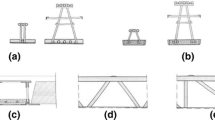Abstract
This paper describes an experimental study of the hysteretic behavior of prestressed truss concrete composite beams (PTCCBs) under cyclic loading. Five beam models were designed and tested, in which the testing parameters include the global reinforcement index β 0, the prestress level λ and the ratio of stirrup ρ sv in the potential plastic hinge zones. Based on the test results, the failure mode and hysteretic behavior of the tested models are obtained. In addition, the P-Δ and sectional M-φ hysteretic models for the PTCCBs at the midspan are established. The P-Δ hysteretic model shows good agreement with the test results.
Similar content being viewed by others
References
China Construction Ministry (1997), Specification of Testing Methods for Earthquake Resistant Building, Beijing: China Architecture Industry Press. (in Chinese)
China Construction Ministry (2001), Technical Specification for Steel Referenced Concrete Composite Structure, Beijing: China Architecture Industry Press. (in Chinese)
China Construction Ministry (2002), Code for Design of Concrete Structures, Beijing: China Architecture Industry Press. (in Chinese)
Clough RW and Johnson SB (1966) “Effect of Stiffness Degradation on Earthquake Ductility Requirement,” Proceeding of the 2nd Earthquake Engineering Symposium, Tokyo, Japan, pp.227–232.
Hao JP and Chen SF (1996) “Numerical Model for the Hysteretic Behavior of Steel Structures Under Cyclic Loading,” Journal of Xi’an University of Architecture & Technology, 28(2): 53–58. (in Chinese)
Roufaiel MSL and Meyer C (1987) “Analytical Modeling of Hysteretic Behavior of R/C Frames,” Journal of Structural Engineering, ASCE, 113(3): 429–444.
Fukada Y (1969) “A Study on the Restoring Force Characteristics of Reinforced Concrete Buildings,” Proceedings of Kanto District Symposium of AIJ, Tokyo, Japan.
Zheng WZ, Liu T, Tan J, et al (2006), “Design Methods and Construction Techniques for the Outer-jacketing Structure Reconstruction (Extension) Project of the Suifenhe Qingyun Market,” China Civil Engineering Journal, 39(11): 68–76. (in Chinese)
Zheng WZ and Sun XJ (2008), “Methods and Practice on Adding Storeyes Around Existing Buildings,” Concrete Engineering International, 12(3): 62–63.
Zheng WZ, Wang Y, Liu T, et al. (2005), “Thoughts and Understanding of Remodeling of Adding Stories Around Existing Building,” Industrial Construction, 4(35): 1–5. (in Chinese)
Zheng WZ, Zhang GM, Liu XD, et al. (2007a) “Experiment on Cave-in Ultimate Bearing Capacity of Grouted-square-steel Tube,” Journal of Jilin University (Engineering and Technology Edition), 37(4): 794–799. (in Chinese)
Zheng WZ, Zhang GM, Liu XD, et al. (2007b) “Experimental Research on Ultimate Bearing Capacity of N-joints of Grouted Square Steel Tube Trusses,” Journal of Southeast University, 23(4): 566–570. (in Chinese)
Author information
Authors and Affiliations
Corresponding author
Additional information
Supported by: National Science and Technology Support Program Subtopics Under Grant No. 2006BAJ03A10-07; Changjiang Scholars Program of China
Rights and permissions
About this article
Cite this article
Zheng, W., Wang, K. & Zhang, G. Experimental study on hysteretic behavior of prestressed truss concrete composite beams. Earthq. Engin. Engin. Vib. 9, 65–74 (2010). https://doi.org/10.1007/s11803-010-8109-5
Received:
Accepted:
Published:
Issue Date:
DOI: https://doi.org/10.1007/s11803-010-8109-5




